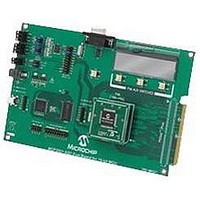MCP3901EV-MCU16 Microchip Technology, MCP3901EV-MCU16 Datasheet - Page 21

MCP3901EV-MCU16
Manufacturer Part Number
MCP3901EV-MCU16
Description
BOARD EVAL FOR 2CH ADC MCP3901
Manufacturer
Microchip Technology
Datasheets
1.MCP3901A0-ISS.pdf
(60 pages)
2.MCP3901A0-ISS.pdf
(30 pages)
3.MCP3901EV-MCU16.pdf
(38 pages)
4.MCP3901EV-MCU16.pdf
(38 pages)
Specifications of MCP3901EV-MCU16
Number Of Adc's
2
Number Of Bits
24
Data Interface
SPI™
Inputs Per Adc
1 Differential
Input Range
±1 V
Voltage Supply Source
Analog and Digital
Operating Temperature
-40°C ~ 85°C
Utilized Ic / Part
MCP3901
Silicon Manufacturer
Microchip
Application Sub Type
ADC
Kit Application Type
Data Converter
Silicon Core Number
MCP3901, PIC24F, PIC24H, DsPIC33, PIC18F86J55
Kit Contents
Board
Lead Free Status / RoHS Status
Lead free / RoHS Compliant
4.8
Integral nonlinearity error is the maximum deviation of
an ADC transition point from the corresponding point of
an ideal transfer function, with the offset and gain
errors removed, or with the end points equal to zero.
It is the maximum remaining error after calibration of
offset and gain errors for a DC input signal.
4.9
For the MCP3901 ADC, the Signal-to-Noise ratio is a
ratio of the output fundamental signal power to the
noise power (not including the harmonics of the signal),
when the input is a sinewave at a predetermined
frequency. It is measured in dB. Usually, only the
maximum Signal-to-Noise ratio is specified. The SNR
calculation mainly depends on the OSR and DITHER
settings of the device.
EQUATION 4-4:
4.10
The most important figure of merit, for the analog
performance of the ADCs present on the MCP3901, is
the
specification.
Signal-to-Noise and distortion ratio are similar to the
Signal-to-Noise ratio, with the exception that you must
include the harmonics power in the noise power calcu-
lation. The SINAD specification mainly depends on the
OSR and DITHER settings.
EQUATION 4-5:
The calculated combination of SNR and THD per the
following formula also yields SINAD:
EQUATION 4-6:
© 2010 Microchip Technology Inc.
SINAD dB
SINAD dB
Signal-to-Noise
SNR dB
Integral Nonlinearity Error
Signal-to-Noise Ratio (SNR)
Signal-to-Noise Ratio And
Distortion (SINAD)
(
(
(
)
=
)
)
10
=
=
log
10
10
SIGNAL-TO-NOISE RATIO
SINAD EQUATION
SINAD, THD AND SNR
RELATIONSHIP
⎛
⎝
log
log
-------------------------------------------------------------------- -
Noise
and
⎛
⎝
SignalPower
--------------------------------- -
10
NoisePower
⎛
⎝
+
SignalPower
SNR
---------- -
10
HarmonicsPower
Distortion
⎞
⎠
+
10
⎛
⎝
⎞
⎠
–
--------------- -
THD
10
(SINAD)
⎞
⎠
⎞
⎠
4.11
The total harmonic distortion is the ratio of the output
harmonic’s power to the fundamental signal power for
a sinewave input and is defined by
EQUATION 4-7:
The THD calculation includes the first 35 harmonics for
the MCP3901 specifications. The THD is usually only
measured with respect to the 10 first harmonics. THD
is sometimes expressed in %. For converting the THD
in %, here is the formula:
EQUATION 4-8:
This specification depends mainly on the DITHER
setting.
4.12
SFDR is the ratio between the output power of the
fundamental and the highest spur in the frequency
spectrum. The spur frequency is not necessarily a har-
monic of the fundamental, even though it is usually the
case. This figure represents the dynamic range of the
ADC when a full-scale signal is used at the input. This
specification depends mainly on the DITHER setting.
EQUATION 4-9:
THD dB
SFDR dB
Total Harmonic Distortion (THD)
Spurious-Free Dynamic Range
(SFDR)
(
(
THD %
)
=
)
=
( )
10
10
log
=
log
⎛
⎝
---------------------------------------------------- -
FundamentalPower
100 10
⎛
⎝
HarmonicsPower
FundamentalPower
---------------------------------------------------- -
HighestSpurPower
×
MCP3901
THD dB
------------------------
Equation
DS22192C-page 21
20
(
)
4-7:
⎞
⎠
⎞
⎠











